Homebrew #41: Medusa Pale Ale
¶ by Rob FrieselBlame Aaron. A Facebook thread talking through which “new” and/or “interesting” hops to showcase in an up-coming brew spawned not one but two big brew days. On the one hand: Calypso; and on the other… Humulus lupulus var. neomexicanus — the wild North American varietal otherwise known as Medusa.
I couldn’t say no. Burlington Beer Co.’s single hop take on Medusa was a late-Spring favorite of mine. All that bold melon and key lime and tangerine… A beer that highlighted this hop needed to happen.
We got to work on a formulation. Something in “the New England style” — hazy and hoppy, “juicy”, with that soft mouthfeel. A few of us developed recipes, trading notes back and forth until we settled on something we all agreed would work.
A pretty straightforward grain bill, it turned out: 90% pale malt, 7% Munich I, and 3% wheat malt. Given Medusa’s low alpha acid content, we decided against making it a single hop; we would use Magnum to get the bitterness level we wanted, then add the first round of Medusa as a late addition, then a ton of Medusa in the whirlpool, and then dry hop the hell out of it. Specific yeast strains were up to the individual co-brewers, but most agreed that London III was a great fit.
Brew Day
Aaron and I got the early start, collecting and adjusting the water (see also: brew day Bru’n Water sheet), and mashing in at 151°F. The mega-BIAB batch had a 60 minute saccharification rest.
We pulled the bag and sparged up to our 27 gallon pre-boil volume.
We rocked a 60 minute boil, with the Magnum addition at 60, the first Medusa at 5, and then a 15 minute whirlpool (with Aaron’s new toy 1) addition of Medusa once we’d dropped the temperature to 145°F.
Once chilled the rest of the way down, we did a little post-boil science. We had an O.G. of 1.057 and 24 gallons to split 6 ways.
Fermentation
Later that night, I pitched from my starter of Wyeast 1318 London III. As has become my custom, I’d over-built the starter, decanted off the supernatant, harvested 400 mL, and pitched the rest. I set my temperature controller to 67±1°F and by +21 hours, I had a nice big, healthy-looking krausen.
For the most part, the fermentation ran its course rather nicely. I’d never fermented with this strain before, and though I’d heard plenty of good things, I found that… while I wouldn’t go so far as to say that it stalled, it did seem to take a few days longer to reach terminal gravity than it did for my co-brewers. Nevertheless, just shy of two weeks, the gravity reading suggested it was plenty close to where I should expect it to be, and I added the dry hops.
I let the beer condition on those dry hops for 3 days before packaging. Giving in to my impatience, I did a quick crash — dropping the fermentation chamber temperature to 32°F and letting it rest for about 12 hours. That night, I took a sample, performed a final gravity reading, and kegged it.
After temperature calibration and offset adjustments, my final gravity was 1.011. I set the CO₂ regulator to approximately 24 PSI (per my protocol) and force carbonated for two days before dropping the pressure and pulling the first sample.
A Brief Aside About Intense Aromas
After kegging the beer, I brought the carboy upstairs to clean it. My 5 year old, who we affectionately refer to as “the fruit monster” (because of his predilection for fruit), came running into the kitchen from the other room, LEGOs in hand. “Are you making watermelon?” he asked, his nose sniffing through the air. I took a whiff from the dirty carboy — yeast cake and hop matter just emanating melon and lime and tropical fruit aromas. “Is it this?” I asked him. He looked at me skeptically. He sniffed the carboy. He furrowed his brow. “Smells like watermelon,” he muttered, disappointment creeping into his voice.
TRUE STORY.
Overall Impressions
The first pour needed just a little more carbonation but (having come back to it a few days later) — I can attest that it lived up to its promise.
AROMA. Ripe melon. Melon and lime flesh and lime zest and tangerine. Malts are in the background; a little bready, a little sweet. Light touch of esters. But those hops go on for days; everything is subordinate to them.
APPEARANCE. Orange-gold and hazy, opaque for all practical purposes. Half-inch stand of white foam with good persistence. Fine, fast-rising bubbles.
FLAVOR. Follows the aromas. Hop-forward, with fruity flavors throughout. Melon and lime and tangerine, hints of soft tropical fruits (especially papaya and mango). Delicate malt backbone, more biscuit than bread on the palate. Balance leans to bitterness, but not aggressively so. Suggestions of creamy sweetness retronasally.
MOUTHFEEL. Medium body with a fine carbonation, but with a rich quality that suggests a greater fullness. Silky and creamy. No astringency.
Overall? We really brought together an outstanding beer that nicely showcases the hops. We had almost instant gratification, too. Yakima Valley Hops asked for the recipe. And the beer took second in the Standard IPA category at the 2017 Champlain Valley Fair’s homebrew competition. We’re also gearing up to do a presentation on neomexicanus (and samplings, of course) at the next Green Mountain Mashers club meeting. The hard part will be restraining myself from drinking it all before then…
Changes for next time? Probably just tweaks, and even then mostly in the water profile. The majority of the aroma came (I believe) from the dry hopping. I’d probably use half as much Medusa in the whirlpool, but a comparable amount of dry hops. London III worked well enough for the fermentation, but I’m a fan of 1332 (Northwest Ale) and would be curious how well that works. This was also the first time our “Experimental Vermont Brew Crew” did any specific water treatments aside from filtering. I have a sneaking suspicion that the retronasal “creamy sweetness” is from a slightly-too-high level of calcium, from the calcium chloride. That “creamy” mouthfeel is nice, but it’s a little distracting when it gives a “milky” flavor impression. I’m new to the water adjustments though, so that’s all just a hunch.
UPDATE: (9/13/2017) Aaron and I presented about this hop and this brew day at the September 2017 Green Mountain Mashers club meeting. Slides are here: Brewing Medusa
Recipe
The all-grain (BIAB) recipe for Medusa APA is as follows (cribbed and interpreted from Aaron’s original recipe):
Water Chemistry
Starting with the Champlain Water District profile as a base, filter (dechlorinate) and adjust:
- 0.5 g/gal gypsum
- 0.64 g/gal calcium chloride
- 0.1 g/gal epsom salt
- 0.5 mL/gal 88% lactic acid
(Bru’n Water Adjustment Summary)
Mash Grains
- 45 lb. Briess pale malt
- 3 lb. 8 oz. Weyermann Munich I malt
- 1 lb. 8 oz. Rahr white wheat malt
Hop Schedule
- 98 g Magnum (60 min.)
- 224 g Medusa Neomexicanus (5 min.)
- 560 g Medusa Neomexicanus (15 min. steep/whirlpool at 145°F)
- 560 g Medusa Neomexicanus (dry hop 3 days 2)
Yeast
Wyeast 1318 London Ale III 3
Brew Day
- Collect 81.5 qt. water and heat to 162°F. Mash in; hold at 151°F for 60 minutes. No mash out.
- Remove filter bag from water. Squeeze filter bag to extract as much liquid as possible for wort. Fly sparge. Pre-boil volume should be approx. 27 gallons.
- Bring to a boil. Boil for 60 minutes; follow hop schedule as described above.
- Cool to 145°F as rapidly as possible; add 560 g Medusa hops and whirlpool for 15 minutes. When the whirlpool completes, cool the rest of the way to 70°F or lower. Post-boil volume should be approx. 27 gallons. 4
- Aerate wort; pitch 1318 yeast from starter.
- Start fermentation at 67°F.
Beyond Brew Day
- Allow fermentation to complete (approx. 2 weeks) at approx. 67±1°F. As fermentation begins to slow down, consider ramping the temperature to 70±1°F.
- After reaching final gravity, add dry hops and let stand 3 days.
- After dry hopping completes, consider cold crashing 1-3 days before packaging.
- Rack to keg. Purge oxygen from headspace with CO₂. Drop temperature to 38-40°F and store refrigerated until ready to carbonate.
- When ready to carbonate, connect to CO₂ at approx. 25 PSI. After approx. 48 hours, shut off gas and purge headspace. Resume CO₂ at 12-14 PSI. After 2-4 days, shut off gas and purge headspace again. Resume CO₂ at serving pressure.
- Enjoy!
Details
Medusa APA, an American Pale Ale featuring wild neomexicanus hops by the Experimental Vermont Brew Crew
| Original Gravity | 1.057 |
| Final Gravity | 1.011 |
| ABV | 6.0% |
| Attenuation | 79.8% |
| IBU | 35 |
| SRM | 4 |
| Links | Untappd Flickr |
- A brief aside about that whirlpool paddle… First of all, it’s sharp. Watch your fingers! Second, using it while the immersion chiller was in the kettle was not the best idea. It dinged up the Hydra a bit. So take that to your brew day retrospective…[↩]
- Split 6 ways.[↩]
- Per my usual protocol, I over-built the starter (i.e., 1750 mL instead of 875 mL), cold-crashed the night before brew day, decanted the supernatant, harvested half, and pitched the rest.[↩]
- In our case we also divided this up six ways.[↩]
About Rob Friesel
Software engineer by day. Science fiction writer by night. Weekend homebrewer, beer educator at Black Flannel, and Certified Cicerone. Author of The PhantomJS Cookbook and a short story in Please Do Not Remove. View all posts by Rob Friesel →4 Responses to Homebrew #41: Medusa Pale Ale
Pingback: Homebrew #39: Calypsonian | found drama
Pingback: Homebrew #44: Otaku Supper | found drama

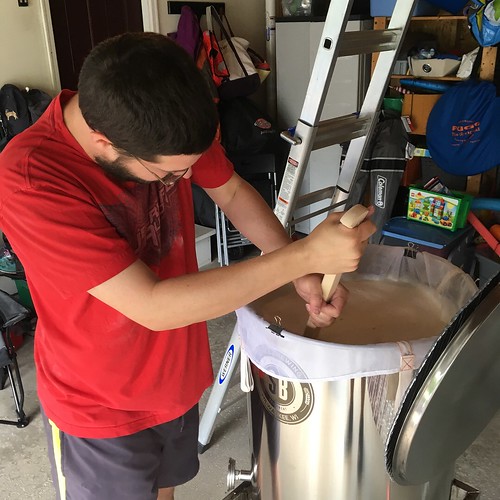
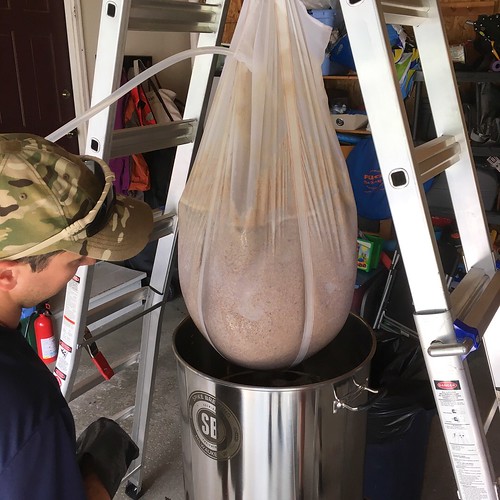
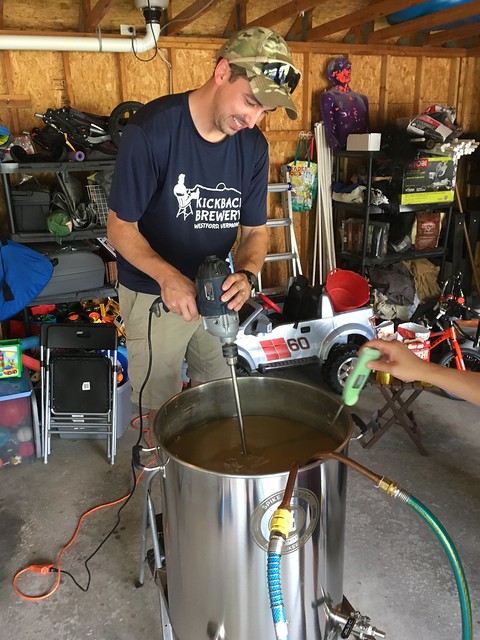

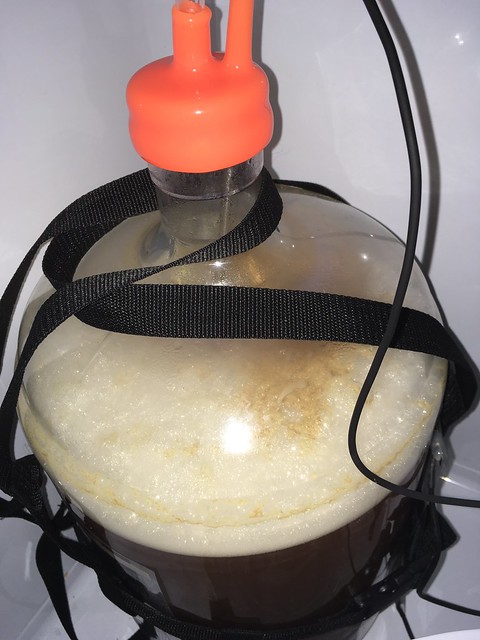
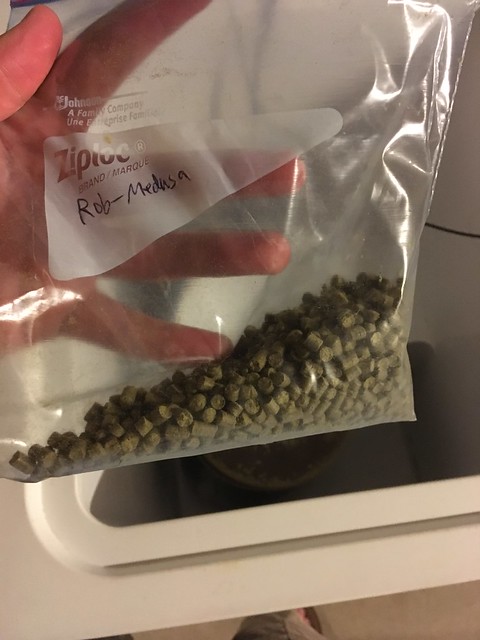
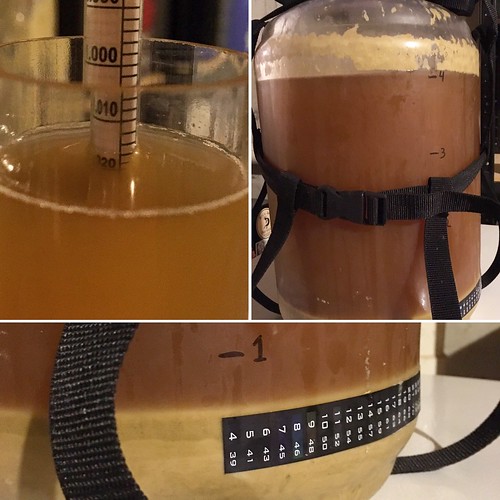
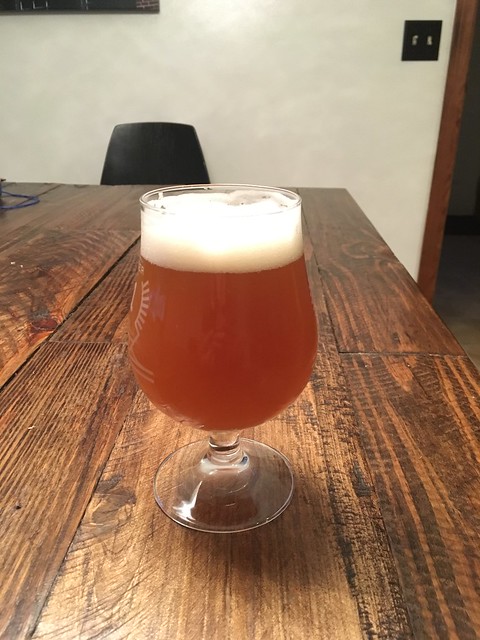
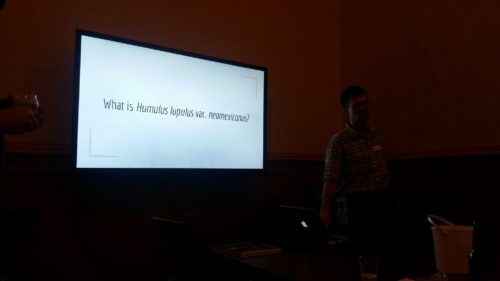
Leave a Reply